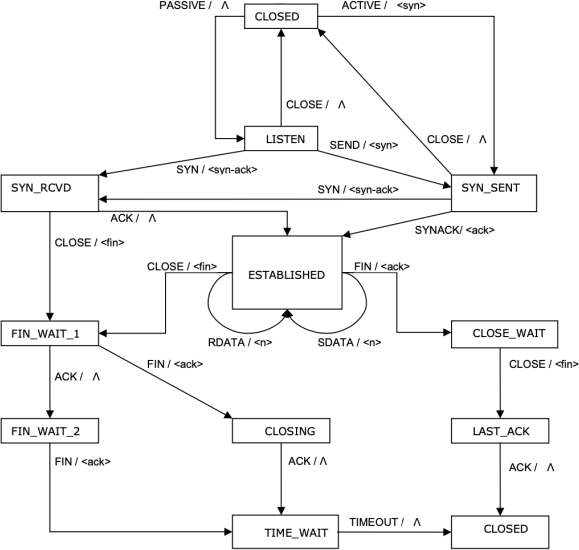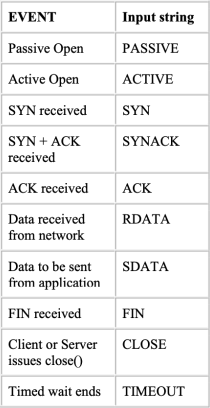To create the JAR file containing your JAVA source code
Hello, dear friend, you can consult us at any time if you have any questions, add WeChat: daixieit
Note:
To create the JAR file containing your JAVA source code (please do not include the class files), change your working directory to the directory where your JAVA files are located and execute the command:
jar cvf N16955291.jar *.java
The associated documentation provided in your zip file MUST include a readme file containing the name of the class that contains the main() method. It should also include a report document that elaborates on the design of your solution and other applicable details.
1. Get introduced to (or re-acquainted with) a very neat computational model called a finite state machine.
2. Build a finite state machine implementation of the TCP connection protocol (3-way handshake) for the both the client (active) side and the server (passive) side of a connection.
3. Leverage a JAVA package that implements a programmable finite state machine to write a program that uses these classes to implement the TCP connection protocol given in Figure 1 below.
4. Since you won’t really get events from a communications link, a sequence of events will be simulated by reading and parsing commands from "standard input" (System.in in Java)

Figure 1 – TCP Connection Protocol (symbol ‘Λ’ means “no action”)
1. Get introduced (or reacquainted) with FSMs:
Finite state machines (FSMs) are used to implement simulations, compilers, and, of most interest to us, communications protocols. You can learn about finite state machines from any text that covers Automata Theory or Theory of Switching Circuits, or from a myriad of sources on the World Wide Web. For our purposes, here is what you need to know:
Machines are devices that respond to a set of stimuli (events) by generating predictable responses (actions) based on a history of prior events (current state).
Any object that behaves according to this stimulus/response relationship may be considered as a machine.
In order to represent a machine as a computational model, you need to define:

· ‘States’ represent the particular configurations that a machine can assume.
· ‘Events’ define the various inputs that a machine will recognize
· ‘Transitions’ represent a change of state from a current state to another (possibly the same) state that is dependent upon a specific event. In a Mealy machine, an FSM may generate an output upon a transition.
· The Start State is the state of the machine before is has received any events.
Generally, finite a state machine is classified as either a Mealy machine – one that generates an output for each transition, or a Moore machine - one that generates an output for each state.
Moore machines can do anything a Mealy machine can do (and vice versa).
Practically, Mealy machines are more useful for implementing communications protocols.
The FSM that you will experiment with in this assignment is a Mealy machine.
2. Understand program inputs requirements:
The program MUST accept as input (from standard input) the Strings for events in the following table

Events in standard input will be separated by white space (note: EOL is also white space!).
NOTE 1: Events must be specified exactly as shown in the table above. All events must be entered in uppercase letters only. Any parsed token (word) that does not exactly match one of these should be treated as invalid (incorrect) input.
NOTE 2: Figure 1 shows a transition from LISTEN state to SYN-SENT state driven by the SEND event. Your program should not handle this case so you should ignore this transition. A SEND event occurs when a server socket is
converted implicitly from server to client by the owning application doing a write on the server socket.
3. Understand the classes provided in the FSM package:
The classes in the FSM package are:
FSM The finite state machine class.
State An abstract class that you will use to define the states for your FSM.
Event A class that you will use to define the events for your FSM
Transition A class that you will use to define the transitions in your FSM
Action An abstract class that you will use to define the actions that you take on each transition.
FsmException A class used to generate detectable errors in package classes.
The code and documentation for the FSM package is HERE. The package is in a jar file, so you will need to extract it or use the jar file in your classpath.
To use the classes, your JAVA program must import the classes in the Fsm package. The easiest way to use the package is to include the jar file in your class path when you compile and execute. For example, on Unix, you might
try:
javac -cp .;./Fsm.jar myProgram.java to compile myProgram.java, and
java -cp .;./Fsm.jar myProgram to run myProgram
On Windows, the command is the same, but the classpath command argument
is introduced by -cp rather than -classpath.
4. Implement your program to operate as follows:
The program should loop, reading ONE event from standard in and processing that event completely, including display of any output, then continuing to read and process the next event, until end of input stream (end of file)
· You MUST implement ALL of the states shown in the transition diagram.
· You MUST Implement all of the transitions shown in the transition diagram AND the transitions for RDATA and SDATA.
· Notice that there are two transitions in the Established state to handle data events. These are the SDATA (application request to send data) and the RDATA (data received from the network) events that can occur while in the ESTABLISHED State. You should handle these Events by writing an output message:
“DATA received n” when the event is RDATA
"DATA sent n" when the event is SDATA
Where n is a number representing the number of SDATA or RDATA Events received to date, including this (R|S)DATA Event. The transition for the (|S)DATA Event should leave the FSM in the ESTABLISHED State. The purpose of this requirement is to ask you to figure out how to associate a variable with a state. In practice, you would call a data transfer process which would have it's own FSM to implement flow control.
To simplify your task, you may treat ANY String that you read from standard input that is NOT one of the events defined here by writing:
"Error: unexpected Event: xxx"
where xxx is the invalid event. Your program should then continue as if the
“bad” input did not occur.
5. Review the following FAQs:
OK, so how do I use these classes to make an FSM?
1. Create classes for your states (by extending State) and allocate your states.
2. Allocate an FSM, giving it a name and a Start State (see the constructor).
NOTE: Use ONLY the constructor that allows you to specify the FSM name and starting state: public FSM(String fsmName, State start)
3. Create your events (by allocating instances of Event).
4. Create classes for the actions to take on each transition (by extending Action) and allocate your actions.
5. Allocate instances of the Transaction class using the allocated State, Event, and Action objects, and add these Transition objects to your FSM object (see the addTransition() method in FSM).
How to I "send" events into the FSM?
The FSM class has a "doEvent" method that takes an Event object as its input.
What happens when I send an Event to the FSM?
Well, this is a Mealy machine, so the FSM will locate the Transition you defined that associates the Event with the current state of the FSM, then set the current state to the state defined in this Transition as the next state, then it will execute the action method you specified in this Transition's Action object.
What do I do in my "Action" methods?
· For all Transitions EXCEPT those caused by the (R|S)DATA Events, write the message:
· "Event eee received, current State is sss"
where eee is the Event and sss is the current State.
· For the Actions on the ESTABLISHED/(R|S)DATA Transitions, write the message:
· “DATA received n” when the event is RDATA
· "DATA sent n" when the event is SDATA
where n is a number representing the number of SDATA or RDATA Events received to date, including this (R|S)DATA Event.
What do I do if you send my program an Event that is not defined for the
current State?
The FSM.doEvent() method will throw an FsmException if you pass an Event that is not defined for the current State. Make sure that you catch this exception and just display the exception (every Exception has a
toString() method). Your program should then continue as if the “bad” Event did not occur.
How does my program terminate?
When you detect the end of the input stream on standard input, just exit.
2023-11-09